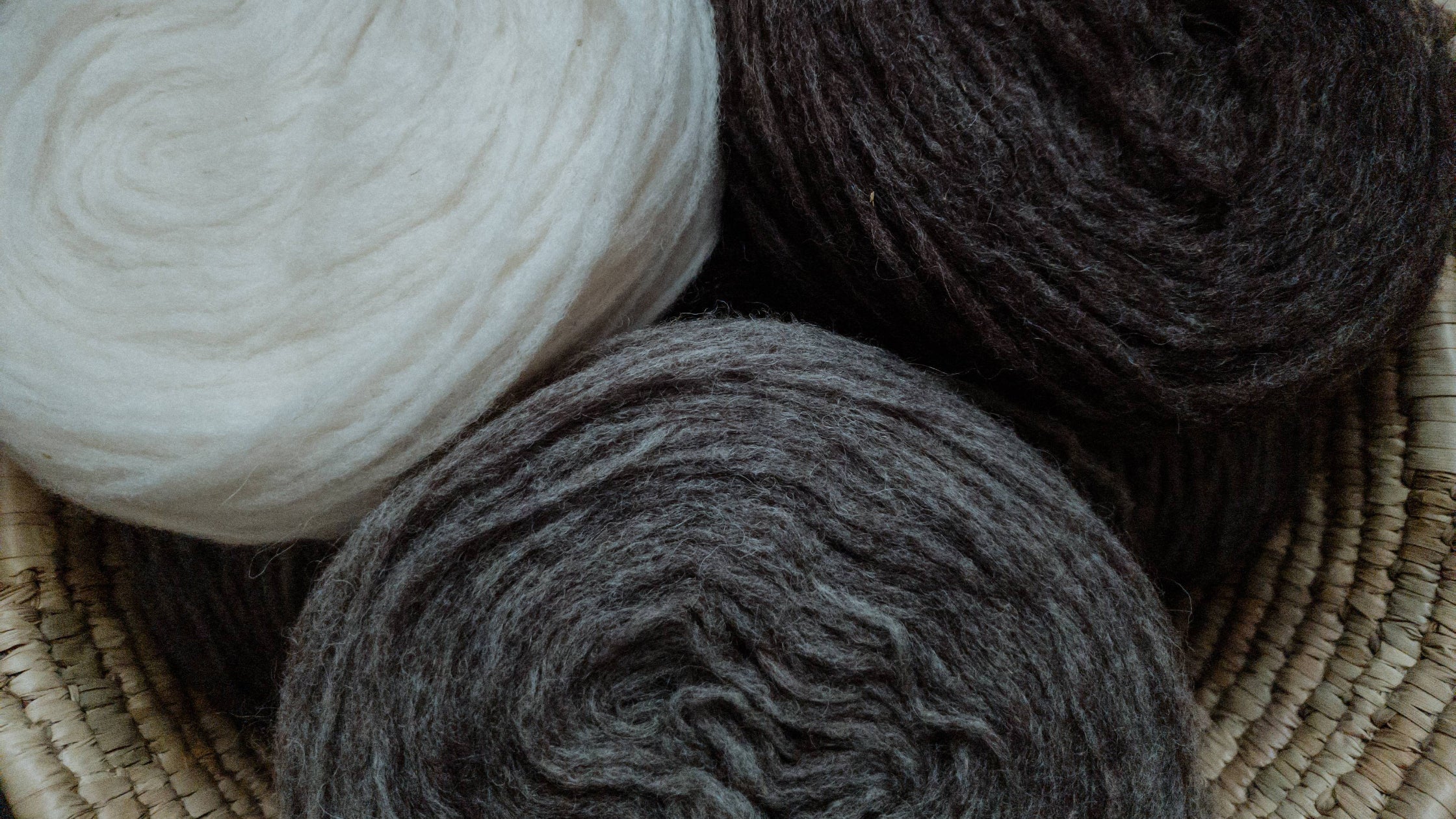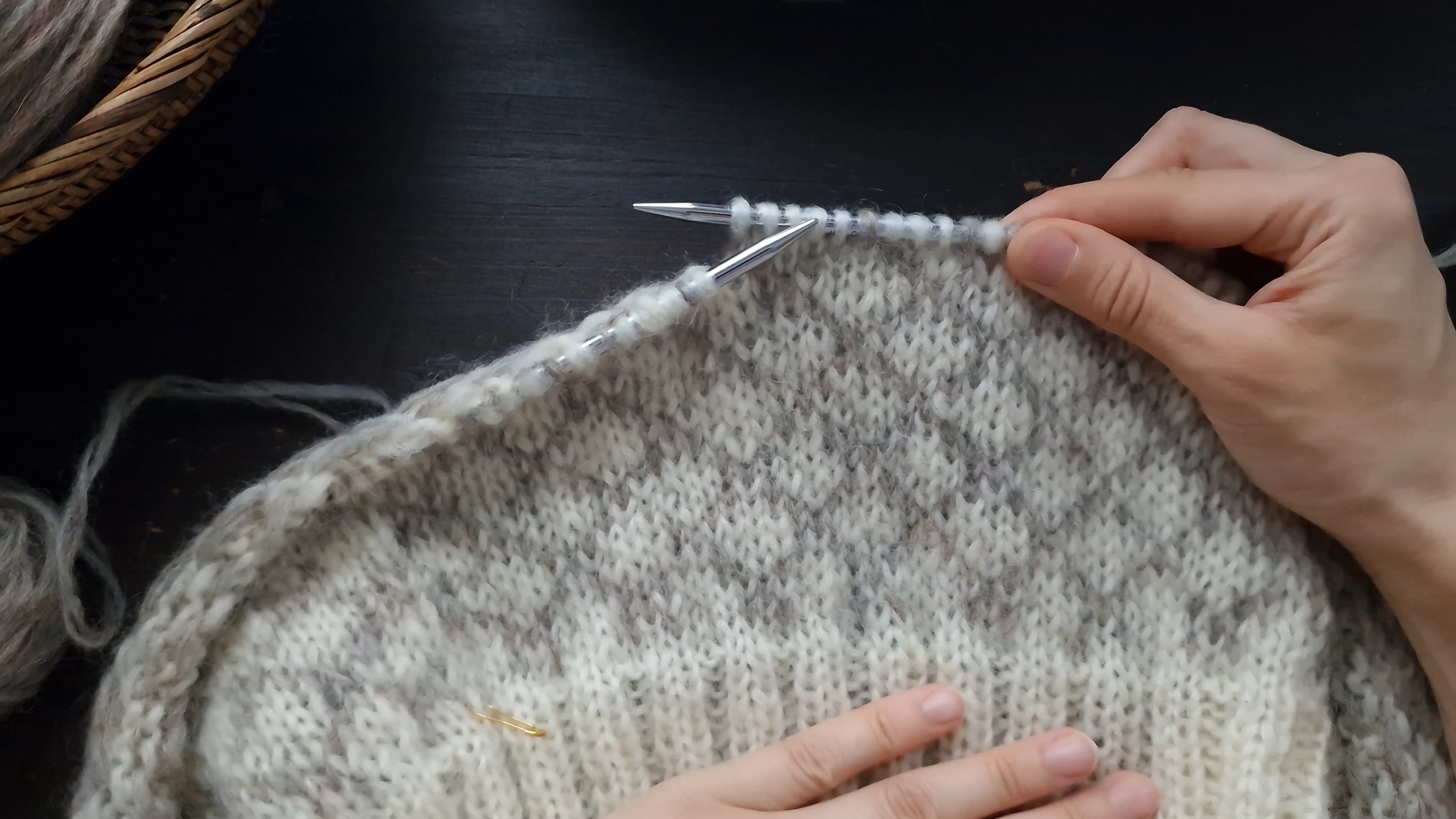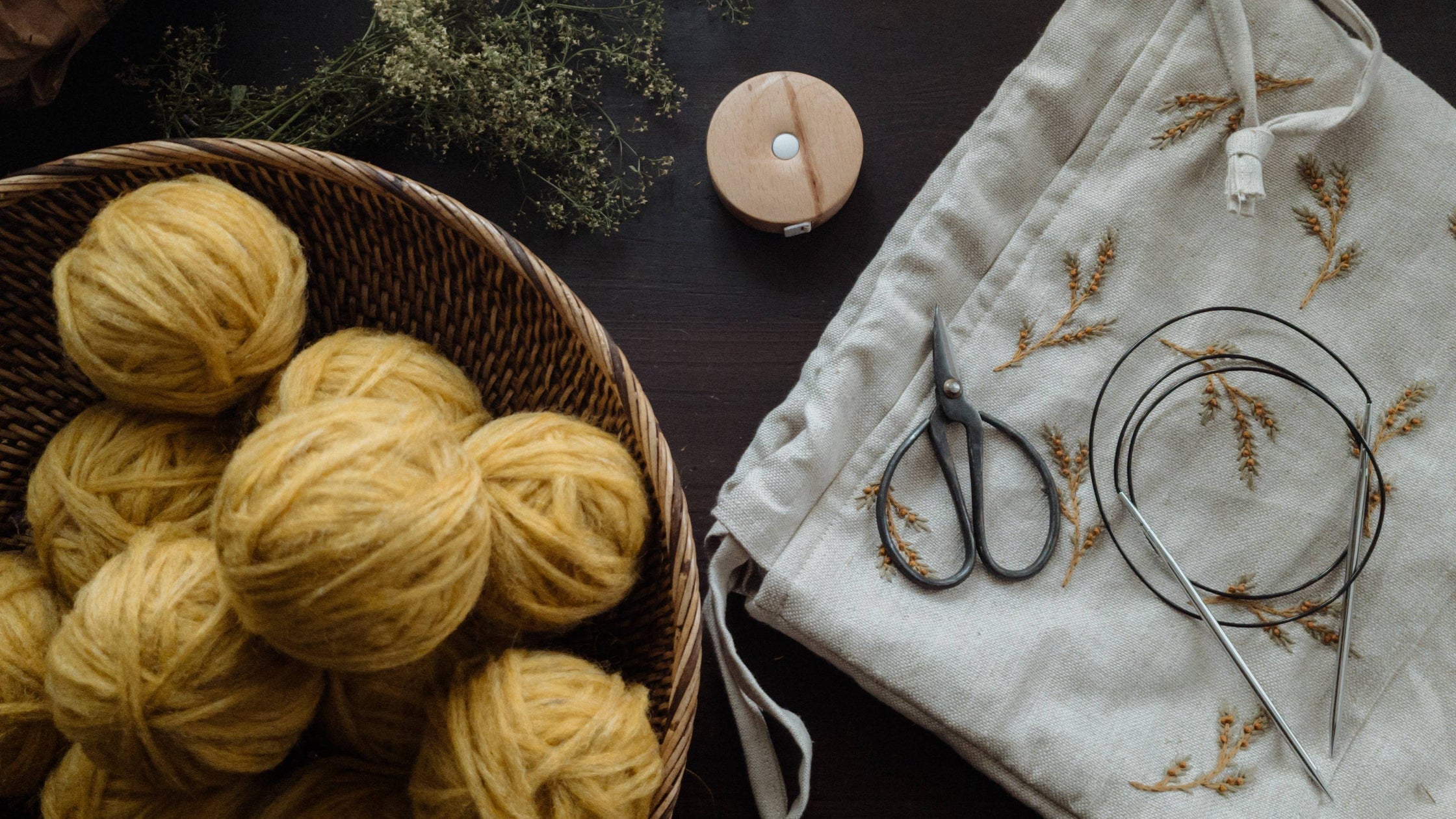The Ultimate Beginners Guide to Unspun Yarn, Part 1: An Introduction

As a knitwear designer and frequent knitter using unspun yarn, I often receive questions about how to work with it. Although I do include some tips in my patterns designed for unspun yarn, I thought it would be beneficial to conduct a deep dive into the topic after all this time. This blog post marks the first part in a series dedicated to unspun yarn, and is intended for knitters and fiber artists unfamiliar with it. If you already have some experience with this type of yarn and are looking for tips and tricks to get started, you might want to check out 'The Ultimate Beginners Guide to Unspun Yarn, Part 2: Working with Unspun Yarn'.
What is unspun yarn?
Unspun yarn, as the name suggests, is a type of yarn that has not undergone the traditional spinning process. Created from wool fibers that have been washed, carded, and sometimes dyed, but not yet twisted into a tightly wound thread, it results in a product that's incredibly soft, lofty, and plush. This unique texture lends itself well to any crafting project. Many fiber artists, including myself, are particularly drawn to unspun yarn because of its raw, natural appearance and its remarkable versatility.
Often referred to as "roving" or "sliver", depending on the precise preparation of the fibers, unspun yarn retains the full loft and elasticity of the wool. These are characteristics that sometimes get lost in the spinning process. In its unspun state, wool retains a raw, untamed quality, giving the fiber artist a sense of connection to the animal the wool originated from, and to the natural world at large.
Understanding the process: from raw wool to the finished product
Before we delve into the process that leads to the creation of unspun yarn, understanding the basics of spinning yarn is crucial. The journey from raw wool to yarn is an interesting one, filled with various steps that each play an important role in determining the yarn's final quality, texture, and strength.
Starting with raw wool, the first step involves washing the wool to remove dirt, oils, and other impurities. This process, also known as scouring, cleans and fluffs up the wool, preparing it for the next stages.
Following washing, the wool goes through carding, a process where the fibers are teased apart and aligned to create a uniform texture. The carding process organizes the raw, washed fibers into a loose alignment, which then becomes 'roving'. The result is a web of fibers that are aligned and ready to be spun.
Combing is a further refining step that aligns the fibers more closely and removes the shorter fibers. When wool is combed and not yet spun, it's often referred to as "top." Top is often used in worsted spinning to produce smoother, more lustrous yarns. Combing is similar to carding but aligns the fibers even more closely and removes the shorter ones, leading to a smoother, more lustrous final product.
The next step in the process is spinning, where the carded or combed wool is twisted into a continuous thread or yarn. The process of spinning gives the yarn its strength, as the twist locks the individual fibers together.
However, unspun yarn skips the spinning stage. It is used in its carded state, without being twisted into a tighter structure, and simply parted into thinner strips and wound into plates or cakes. As it lacks the spinning step, unspun yarn maintains the full loft and softness of the original wool. Although unspun yarn is less durable and stable than spun yarn, its unique texture, appearance, versatility and unparalleled warmth-to-weight ratio have not only earned it a rightful place among fiber artists but also a permanent spot in my yarn stash.
The Appeal and Advantages of Unspun Yarn:

Versatile and Adaptable
Unspun yarn typically comes in plates or cakes single-stranded, meaning there is just one large strand of unspun fibers. However, there are some exceptions where the unspun yarn is already double-stranded.
The weight of unspun yarn can vary, but a single-strand of unspun often falls into the category of light fingering-weight. The exact categorization can depend on the specific type and preparation of the wool. When held double it can correspond to DK, Aran or Worsted weight depending on the particular yarn and blend, and held triple it is akin to a bulky weight yarn.
This ability to adjust the weight of the yarn simply by holding multiple strands together adds a great level of adaptability. Depending on the desired thickness and warmth of the final product, you can choose to use a single strand for a lighter product or multiple strands for something more substantial.
Moreover, it is easy to pair it with different spun fibers to achieve various effects and yarn weights.
Superior Softness
Unspun yarn is known for its remarkable softness. Because the yarn is not tightly spun, it maintains the original softness of the wool. This softness is felt in the finished products, making them more comfortable to wear. It's this level of comfort that makes unspun yarn a popular choice for garments such as sweaters, scarves, and hats.
Unique Texture and Aesthetic Appeal
Unspun yarn offers a unique texture and aesthetic that is different from traditional yarn. Its raw, fluffy look lends a rustic charm and textural richness to the finished products. This aesthetic appeal makes unspun yarn a great choice for those looking to create products with a distinct look and feel.
Due to the lack of spinning, unspun yarn retains the full loft and elasticity of the original wool, giving it a uniquely plush and cosy feel that is hard to achieve with traditionally spun yarns.
Excellent Insulation
Unspun yarn boasts extraordinary insulating properties, making it an ideal choice for outdoor activities such as hiking and camping. The unique structure of it, being not tightly spun, allows it to trap a significant amount of air between its fibers. This trapped air, acting as a natural insulator, forms a barrier that slows the transfer of heat. Garments made from unspun yarn are, therefore, incredibly warm, making them perfect for colder climates or winter seasons.
Breathability
Made from 100% wool, unspun yarn inherently carries the impressive properties of this natural fiber. A key attribute of wool, and hence unspun yarn, is its outstanding breathability, acting as an excellent regulator of body temperature. This quality is particularly beneficial in varying conditions, as wool efficiently retains warmth while concurrently allowing excess body heat and moisture to escape. This unique balance alleviates discomfort and wards off abrupt body temperature fluctuations, providing consistent comfort.
Resistance to elements
Complementing its breathability, wool's inherent water resistance offers a significant advantage. The fibers of unspun wool yarn have a natural waxy coating, repelling water to a certain degree. Certain blends of unspun Nutiden yarn from Höner och Eir, notably, are designed with more lanolin left in, which enhances this water-repelling characteristic. Although this doesn't render the garment entirely waterproof, it guarantees a degree of moisture resistance, ensuring that warmth is sustained even when the yarn is wet.


An Asset for Outdoor Activities
One of the most impressive features of unspun yarn is its superior warmth-to-weight ratio. The blend of the lightweight nature of unspun yarn and its thermal properties strikes an optimal balance between comfort and insulation. This balance is paramount in outdoor gear, where the lightness of the equipment significantly affects mobility and overall outdoor experience.
Speaking from personal experience as an avid hiker and outdoor person, I frequently reach for my Wayfarer Raglan made in unspun Nutiden yarn from Höner och Eir held double or Loki Raglan knitted in Plötulopi held double throughout the colder months. Pairing this with a long-sleeved merino wool base layer for colder days or a merino t-shirt for warmer ones, along with a shell jacket or an anorak for more windy or rainy conditions, creates the perfect balance between warmth, breathability, and adaptability. Despite being lightweight, a sweater made in unspun yarn will not weigh you down in your pack, and you will hardly notice its presence. The only trade-off is the naturally larger volume, but it's a minor consideration given the unbeatable benefits of wool.
And while it's true that garments made from unspun yarn may require a gentler touch when it comes to washing and wear, with proper care, can still allow for creations to last.
Sustainability in Unspun Yarn: Honouring Nature, Farmers, and Heritage
Wool, as a natural and sustainable fiber, often has its production processes deeply intertwined with sustainability practices. Several manufacturers, whether their primary focus is unspun yarn or it forms just part of their offering, uphold key sustainability tenets. They strive to preserve as much of nature in their product as possible, ensure fair pay for farmers, and aim to have a positive socio-economic impact. They also prioritize the preservation of local heritage and the protection of endangered breeds.
Two companies that embody these principles, align with my personal values, and whose yarn I frequently incorporate into my work are Höner och Eir and Wooldreamers. Höner och Eir (@honerocheir), a Swedish manufacturer, produces the unspun Nutiden yarn, while the Spanish company Wooldreamers (@wooldreamers) creates Manchelopis unspun yarn. I highly recommend both of these manufacturers and their yarn, and I encourage you to explore their websites and Instagram profiles to learn more about their values, commitment to sustainability, and unique production processes.
When you delve into the world of unspun yarn, you'll quickly discover that each product is distinct, yet the values of the creators often resonate universally. Holding a plate of unspun yarn that feels like pure nature not only represents the hard work and passion infused into its creation but also connects you more closely with the natural world.
For more insights on my experience with Nutiden yarn, don't forget to check out my previous blog post: 'The Nutiden Connection: Weaving Stories, Stitch by Stitch'.

Final Word
It's this delicate balance of durability, warmth, versatility, and aesthetics that makes unspun yarn an appealing choice for knitters and all fiber artists - one that I wholeheartedly I can recommend. While it may require a different approach compared to traditional spun yarn, the rewards of working with unspun yarn are well worth the extra care and attention and the attention to detail and required care can be viewed instead of a hindrance, an opportunity to foster the connection to the craft, creation and source.
Ready to embark on your own unspun yarn journey? In my next blog post, 'The Ultimate Beginners Guide to Unspun Yarn, Part 2: Working with Unspun Yarn', I'll share some practical tips to make your first exploration into the world of unspun yarn more enjoyable.
If you've found this information insightful and perhaps you're now inspired to incorporate unspun yarn into your own projects, I'd be delighted to see your work! Don't hesitate to share your creations using the hashtags #UnspunYarnGuide and #woodlandsknits, and remember to tag me on Instagram @woodlandsknits. I look forward to seeing your creations. Happy knitting!

